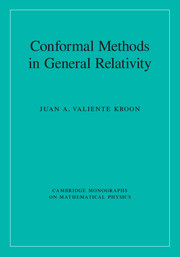Book contents
- Frontmatter
- Dedication
- Contents
- Preface
- Acknowledgements
- List of Symbols
- 1 Introduction
- Part I Geometric tools
- Part II General relativity and conformal geometry
- Part III Methods of the theory of partial differential equations
- Part IV Applications
- 15 De Sitter-like spacetimes
- 16 Minkowski-like spacetimes
- 17 Anti-de Sitter-like spacetimes
- 18 Characteristic problems for the conformal field equations
- 19 Static solutions
- 20 Spatial infinity
- 21 Perspectives
- References
- Index
16 - Minkowski-like spacetimes
from Part IV - Applications
- Frontmatter
- Dedication
- Contents
- Preface
- Acknowledgements
- List of Symbols
- 1 Introduction
- Part I Geometric tools
- Part II General relativity and conformal geometry
- Part III Methods of the theory of partial differential equations
- Part IV Applications
- 15 De Sitter-like spacetimes
- 16 Minkowski-like spacetimes
- 17 Anti-de Sitter-like spacetimes
- 18 Characteristic problems for the conformal field equations
- 19 Static solutions
- 20 Spatial infinity
- 21 Perspectives
- References
- Index
Summary
This chapter studies the existence and stability of Minkowski-like spacetimes, that is, solutions to the vacuum Einstein field equations with vanishing cosmological constant. The main result of this chapter is very similar in spirit to the main result concerning the global existence and stability of de Sitter-like spacetimes of Chapter 15. There is, however, a key difference: while the results in Chapter 15 are global in nature, the ones in the present chapter are semiglobal. More precisely, the spacetimes to be discussed arise as the development of suitable initial data on hyperboloidal hypersurfaces – an examination of the Penrose diagram of the Minkowski spacetime in Figure 16.1 reveals that these hypersurfaces are not Cauchy hypersurfaces of the spacetime. Accordingly, only a portion of the whole spacetime can be recovered from this type of initial value problem. The main result of this chapter can be formulated as follows:
Theorem (semiglobal existence and stability of Minkowski-like spacetimes).Small enough perturbations of hyperboloidal initial data for the Minkowski spacetime give rise to solutions to the vacuum Einstein field equations which exist globally towards the future and have an asymptotic structure similar to that of the Minkowski spacetime.
This result was first proved in Friedrich (1986b) and subsequently extended to the Einstein-Yang-Mills equations in Friedrich (1991). The original proof of the result made use of the standard conformal Einstein field equations and is similar to the argument given for the de Sitter spacetime in Section 15.3. In this chapter a proof of the theorem is given which makes use of the extended conformal field equations and conformal Gaussian systems following the ideas in Lübbe and Valiente Kroon (2009). This approach allows for a more detailed and explicit discussion of the structure of the conformal boundary.
The restriction of the analysis of the present chapter to the hyperboloidal initial value problem may seem mysterious at first sight. As will be discussed in some detail in Chapter 20, the initial data for the conformal Einstein field equations on an asymptotically Euclidean (Cauchy) hypersurface is generically singular at spatial infinity – the various issues associated to this singular behaviour are usually known as the problem of spatial infinity.
- Type
- Chapter
- Information
- Conformal Methods in General Relativity , pp. 437 - 453Publisher: Cambridge University PressPrint publication year: 2016



